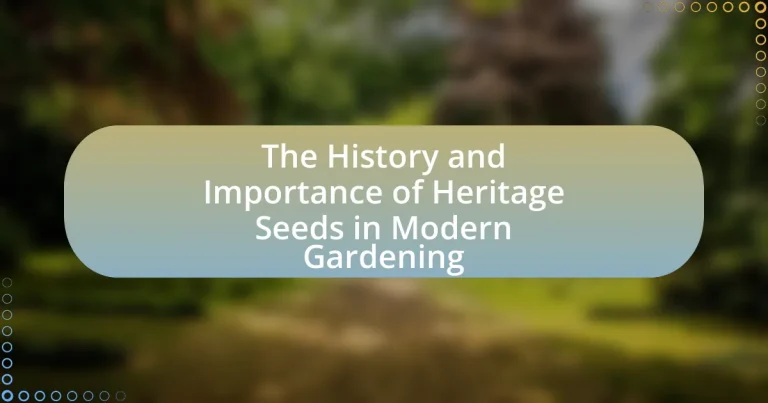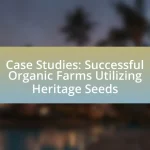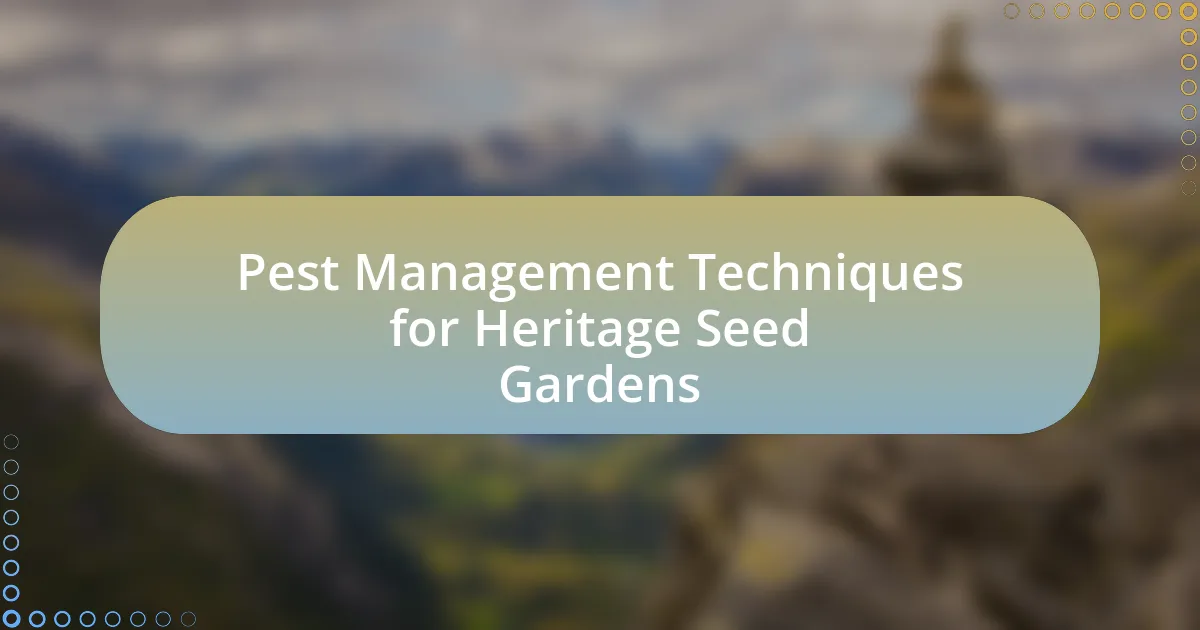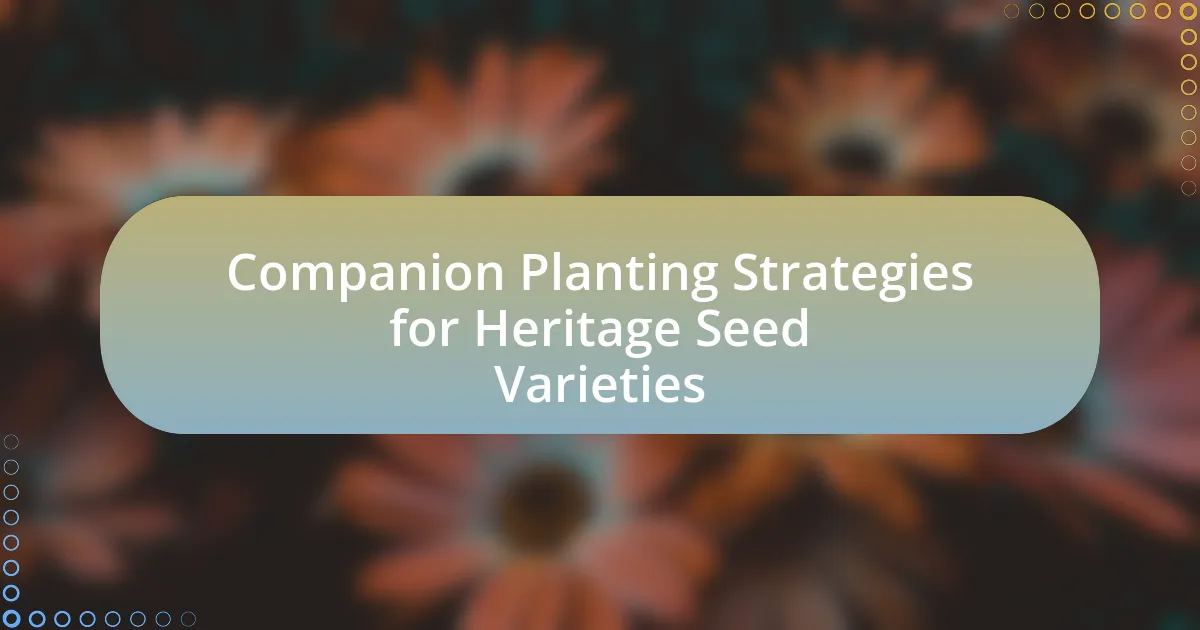Heritage seeds are traditional seed varieties that have been preserved through generations, known for their genetic diversity and adaptability to local environments. This article explores the significance of heritage seeds in modern gardening, highlighting their differences from hybrid and GMO seeds, their historical importance, and their role in promoting sustainable agriculture and food security. It also addresses the challenges faced by heritage seeds today, including the impact of industrial agriculture and monoculture practices, while outlining initiatives for their preservation and the best practices for gardeners interested in utilizing these valuable resources.

What are Heritage Seeds and Why are They Important?
Heritage seeds are traditional seed varieties that have been passed down through generations, often cultivated for their unique traits and adaptability to local environments. They are important because they preserve genetic diversity, which is crucial for food security and resilience against pests and diseases. According to the Seed Savers Exchange, over 90% of the seed varieties available in the early 20th century have been lost, highlighting the need to maintain these heritage varieties to ensure a sustainable agricultural future.
How do Heritage Seeds differ from Hybrid and GMO Seeds?
Heritage seeds differ from hybrid and GMO seeds primarily in their genetic makeup and breeding methods. Heritage seeds are open-pollinated varieties that have been passed down through generations, maintaining their genetic integrity and traits over time, while hybrid seeds are created through controlled cross-pollination of different plant varieties to produce specific traits, and GMO seeds are genetically modified using biotechnology to introduce new traits that do not occur naturally. Heritage seeds are valued for their biodiversity, adaptability, and flavor, whereas hybrids may offer uniformity and higher yields, and GMOs often provide resistance to pests and herbicides. The preservation of heritage seeds is crucial for maintaining agricultural diversity and food security, as evidenced by the fact that over 90% of the world’s food crops are derived from just 30 plant species, highlighting the importance of diverse genetic resources in agriculture.
What characteristics define Heritage Seeds?
Heritage seeds are defined by their open-pollinated nature, which allows them to be naturally pollinated and produce seeds that are true to type. These seeds are typically heirloom varieties, often passed down through generations, and are known for their genetic diversity, adaptability to local growing conditions, and rich flavors. Heritage seeds have historical significance, as many have been cultivated for over 50 years, preserving unique traits and characteristics that are often lost in modern hybrid varieties. This preservation of genetic diversity is crucial for sustainable agriculture and food security, as it allows for resilience against pests and diseases.
Why are Heritage Seeds considered more sustainable?
Heritage seeds are considered more sustainable because they are open-pollinated, allowing them to adapt to local environments over time. This adaptability leads to increased biodiversity, which is crucial for ecosystem resilience. Additionally, heritage seeds are often grown without synthetic fertilizers and pesticides, promoting healthier soil and reducing chemical runoff. Studies show that diverse crop systems, including those using heritage seeds, can enhance soil health and reduce the need for external inputs, making them a more environmentally friendly choice for agriculture.
What historical significance do Heritage Seeds hold?
Heritage seeds hold historical significance as they represent traditional plant varieties that have been cultivated and passed down through generations, often for over 50 years. These seeds are crucial for preserving genetic diversity in agriculture, as they are adapted to local climates and conditions, which enhances resilience against pests and diseases. The preservation of heritage seeds also reflects cultural heritage and agricultural practices, as many varieties are tied to specific regions and communities. For example, the preservation of heirloom tomatoes showcases unique flavors and characteristics that have been maintained through careful cultivation. This historical context underscores the importance of heritage seeds in maintaining biodiversity and supporting sustainable agriculture practices.
How have Heritage Seeds been preserved through generations?
Heritage seeds have been preserved through generations primarily by small-scale farmers and gardeners who prioritize seed saving practices. These individuals cultivate traditional varieties, ensuring their continued availability by collecting and storing seeds from mature plants each season. This method of preservation is supported by organizations such as Seed Savers Exchange, which promotes the sharing and conservation of heirloom seeds, documenting their histories and characteristics. Additionally, community seed banks and local agricultural initiatives play a crucial role in maintaining genetic diversity and protecting these seeds from extinction, thereby reinforcing their importance in sustainable agriculture and biodiversity.
What role did Heritage Seeds play in traditional agriculture?
Heritage seeds played a crucial role in traditional agriculture by preserving genetic diversity and enabling farmers to cultivate crops that were well-adapted to local climates and conditions. These seeds, often passed down through generations, contributed to sustainable farming practices by allowing for the selection of varieties that thrived in specific environments, thus enhancing food security. Historical evidence shows that heritage seeds were integral to the agricultural practices of various cultures, as they provided reliable yields and resilience against pests and diseases, which is essential for maintaining agricultural biodiversity.
Why should modern gardeners consider using Heritage Seeds?
Modern gardeners should consider using Heritage Seeds because they offer genetic diversity, resilience, and unique flavors that are often lost in commercial hybrids. Heritage Seeds, which are open-pollinated and have been passed down through generations, provide a stable genetic makeup that can adapt to local growing conditions, enhancing biodiversity in gardens. Studies show that these seeds can contribute to sustainable agriculture by promoting soil health and reducing dependency on chemical inputs. Additionally, many Heritage varieties have superior taste profiles compared to their hybrid counterparts, making them a preferred choice for culinary enthusiasts.
What benefits do Heritage Seeds offer in terms of biodiversity?
Heritage seeds enhance biodiversity by preserving genetic diversity within plant species. This preservation is crucial as it allows for a wider range of traits that can contribute to resilience against pests, diseases, and climate change. According to the Food and Agriculture Organization, heritage seeds represent a significant portion of the world’s agricultural biodiversity, with thousands of varieties that have adapted to local conditions over generations. By maintaining these seeds, gardeners and farmers can support ecosystems and promote sustainable agricultural practices, ensuring that diverse plant genetics remain available for future cultivation.
How do Heritage Seeds contribute to food security?
Heritage seeds contribute to food security by preserving genetic diversity in crops, which enhances resilience against pests, diseases, and climate change. This genetic diversity allows farmers to adapt their crops to local conditions and maintain stable food supplies. For instance, heritage varieties often have traits that enable them to thrive in specific environments, reducing reliance on chemical inputs and promoting sustainable agriculture. According to the Food and Agriculture Organization, maintaining diverse seed varieties is crucial for ensuring food security, as it helps safeguard against the loss of crops due to environmental changes or market fluctuations.

What Challenges do Heritage Seeds Face Today?
Heritage seeds face several challenges today, primarily due to industrial agriculture practices, loss of biodiversity, and climate change. Industrial agriculture often prioritizes high-yield, genetically modified crops, which diminishes the market for heritage seeds and reduces their cultivation. The loss of biodiversity is significant, as many heritage varieties are not being preserved, leading to a decline in genetic diversity essential for resilient ecosystems. Climate change further complicates the situation by altering growing conditions, making it difficult for certain heritage varieties to thrive in their traditional environments. According to a report by the Food and Agriculture Organization, about 75% of crop diversity has been lost over the last century, highlighting the urgent need to address these challenges for the preservation of heritage seeds.
How has industrial agriculture impacted Heritage Seeds?
Industrial agriculture has significantly diminished the prevalence and diversity of Heritage Seeds. The rise of monoculture practices in industrial agriculture has led to a focus on high-yield, uniform crop varieties, which often displaces traditional, locally adapted seeds. According to the Food and Agriculture Organization, approximately 75% of crop diversity has been lost since the 1900s, largely due to the dominance of industrial farming methods that prioritize a limited number of commercial seed varieties over the diverse genetic resources found in Heritage Seeds. This shift not only threatens the genetic diversity essential for food security but also undermines the cultural and historical significance of these seeds, which have been cultivated for generations.
What are the threats posed by monoculture farming practices?
Monoculture farming practices pose significant threats to biodiversity, soil health, and ecosystem stability. By cultivating a single crop species over large areas, monoculture reduces genetic diversity, making crops more susceptible to pests and diseases. For instance, the Irish Potato Famine in the 1840s exemplifies how reliance on a single potato variety led to widespread crop failure and famine when a disease struck. Additionally, monoculture depletes soil nutrients, as the same crop continuously extracts specific minerals, leading to soil degradation and increased reliance on chemical fertilizers. This practice also disrupts local ecosystems, as it eliminates habitats for various species, contributing to a decline in pollinators and other beneficial organisms.
How do market trends affect the availability of Heritage Seeds?
Market trends significantly influence the availability of Heritage Seeds by determining consumer demand and production focus. When there is a growing interest in organic and sustainable gardening, the demand for Heritage Seeds increases, prompting suppliers to stock more varieties. Conversely, if market trends shift towards hybrid or genetically modified seeds, producers may reduce their offerings of Heritage Seeds, leading to decreased availability. For instance, a report from the Seed Savers Exchange indicates that as consumer preferences lean towards biodiversity and traditional farming practices, the market for Heritage Seeds has expanded, resulting in more seed companies prioritizing these varieties.
What initiatives are in place to protect Heritage Seeds?
Various initiatives are in place to protect Heritage Seeds, including seed banks, conservation programs, and legal frameworks. Seed banks, such as the Svalbard Global Seed Vault, preserve genetic diversity by storing seeds from around the world, ensuring they are safeguarded against extinction. Conservation programs, often led by non-profit organizations and agricultural institutions, focus on cultivating and promoting the use of Heritage Seeds in local communities, thereby maintaining their availability and cultural significance. Additionally, legal frameworks, such as the International Treaty on Plant Genetic Resources for Food and Agriculture, support the protection of traditional varieties by recognizing farmers’ rights and promoting sustainable agricultural practices. These initiatives collectively contribute to the preservation of Heritage Seeds for future generations.
How do seed banks contribute to the preservation of Heritage Seeds?
Seed banks contribute to the preservation of Heritage Seeds by collecting, storing, and maintaining genetic diversity of these seeds for future generations. They safeguard traditional varieties that may be at risk of extinction due to industrial agriculture practices, climate change, and loss of biodiversity. For instance, the Svalbard Global Seed Vault, established in 2008, houses over a million seed samples from around the world, ensuring that unique genetic traits of Heritage Seeds are preserved. This proactive approach helps maintain agricultural resilience and supports food security by providing a resource for breeding programs and restoration efforts.
What role do community gardens play in promoting Heritage Seeds?
Community gardens play a crucial role in promoting heritage seeds by providing a platform for the cultivation and preservation of these traditional varieties. These gardens often focus on biodiversity and sustainable practices, allowing gardeners to grow and share heritage seeds that may otherwise be lost. For instance, community gardens frequently host seed swaps and educational workshops, which facilitate the exchange of knowledge and seeds among participants, thereby increasing awareness and appreciation for heritage varieties. Research indicates that community gardening initiatives can enhance local food security and biodiversity, as evidenced by studies showing that urban gardens contribute to the conservation of heirloom plant varieties, which are vital for maintaining genetic diversity in agriculture.

How Can Gardeners Successfully Use Heritage Seeds?
Gardeners can successfully use heritage seeds by selecting varieties that are well-suited to their local climate and soil conditions, ensuring optimal growth and yield. Heritage seeds, which are open-pollinated and often heirloom varieties, allow gardeners to save seeds from their plants for future planting, promoting biodiversity and sustainability. Research indicates that heritage seeds can enhance flavor and nutritional value, as many heirloom varieties have been cultivated for taste over generations. Additionally, gardeners should practice crop rotation and companion planting with heritage seeds to improve soil health and pest resistance, further supporting successful gardening practices.
What are the best practices for planting Heritage Seeds?
The best practices for planting heritage seeds include selecting a suitable location, preparing the soil, and ensuring proper planting depth and spacing. Heritage seeds thrive in well-drained, nutrient-rich soil, so it’s essential to amend the soil with organic matter, such as compost, to enhance fertility. Additionally, planting heritage seeds at the recommended depth—typically two to three times the seed’s diameter—and maintaining adequate spacing between plants allows for optimal growth and air circulation. These practices are supported by agricultural studies indicating that proper soil preparation and planting techniques significantly improve seed germination and plant health, ensuring a successful harvest of heritage varieties.
How should soil preparation differ for Heritage Seeds?
Soil preparation for Heritage Seeds should focus on enhancing soil biodiversity and maintaining organic matter. Heritage Seeds, which are open-pollinated varieties, thrive in nutrient-rich, well-aerated soil that supports beneficial microorganisms. This can be achieved by incorporating organic compost and avoiding synthetic fertilizers, which can disrupt the natural soil ecosystem. Research indicates that organic matter improves soil structure and water retention, crucial for the healthy growth of these traditional varieties. Additionally, soil pH should be tested and adjusted to optimal levels for specific heritage crops, as many of these seeds have adapted to particular soil conditions over generations.
What watering and fertilization techniques are recommended for Heritage Seeds?
Heritage seeds require consistent watering and balanced fertilization techniques to thrive. It is recommended to water them deeply and infrequently, ensuring the soil remains moist but not waterlogged, which promotes strong root development. Fertilization should involve organic options such as compost or well-rotted manure, applied at planting and during the growing season to provide essential nutrients. Research indicates that organic fertilizers enhance soil health and improve plant resilience, making them particularly suitable for heritage varieties that often have specific nutrient needs.
What common challenges do gardeners face with Heritage Seeds?
Gardeners commonly face challenges with Heritage Seeds, including lower germination rates, susceptibility to pests and diseases, and difficulty in adapting to modern growing conditions. Heritage Seeds, often heirloom varieties, may not have the same resilience as hybrid seeds, leading to inconsistent growth and yield. For instance, a study by the Seed Savers Exchange indicates that heirloom varieties can have germination rates as low as 50% compared to hybrids, which often exceed 90%. Additionally, these seeds may require specific soil types and climate conditions, making them less versatile for gardeners in diverse environments.
How can pests and diseases be managed in Heritage Seed gardens?
Pests and diseases in Heritage Seed gardens can be managed through integrated pest management (IPM) strategies, which include cultural practices, biological control, and the use of resistant varieties. Cultural practices such as crop rotation, proper spacing, and sanitation help reduce pest populations and disease incidence. Biological control involves introducing natural predators or beneficial organisms that target specific pests, thereby minimizing chemical interventions. Additionally, selecting heritage seed varieties that exhibit resistance to certain diseases can significantly lower the risk of outbreaks. Research indicates that these methods not only protect the integrity of heritage seeds but also promote biodiversity and sustainability in gardening practices.
What troubleshooting tips can help ensure a successful harvest?
To ensure a successful harvest, gardeners should regularly monitor soil moisture levels, as consistent watering is crucial for plant health. Maintaining appropriate nutrient levels through soil testing can also prevent deficiencies that hinder growth. Additionally, implementing pest control measures, such as using organic pesticides or introducing beneficial insects, can protect crops from damage. Crop rotation and diversity can further enhance soil health and reduce disease risk. Research indicates that these practices significantly improve yield and quality, as evidenced by studies showing that proper irrigation and pest management can increase harvests by up to 30%.
What resources are available for gardeners interested in Heritage Seeds?
Gardeners interested in Heritage Seeds can access a variety of resources, including seed banks, online databases, and educational organizations. Seed banks, such as the Seed Savers Exchange, offer a wide selection of heritage seeds and promote the preservation of heirloom varieties. Online databases like the USDA’s National Plant Germplasm System provide detailed information on heritage seed varieties, including their origins and characteristics. Additionally, organizations such as the Heritage Seed Library offer resources and workshops to educate gardeners on the importance and cultivation of heritage seeds, ensuring the continuation of these traditional varieties.





